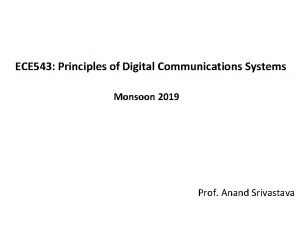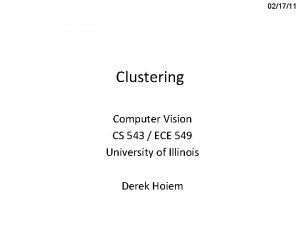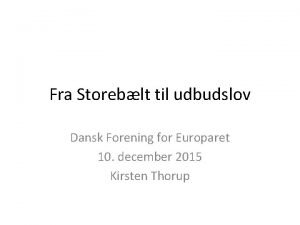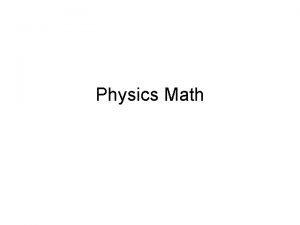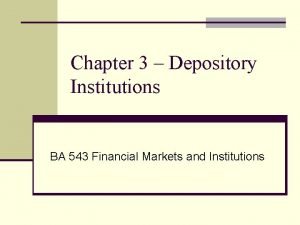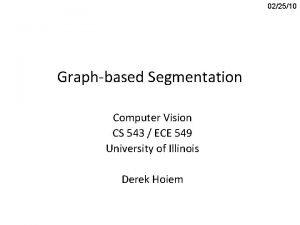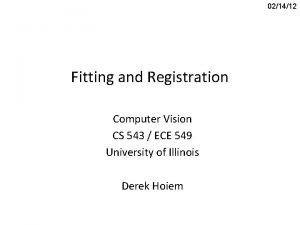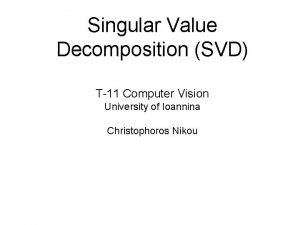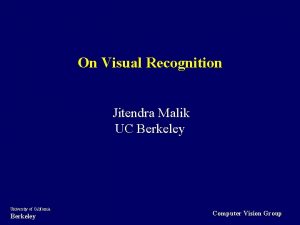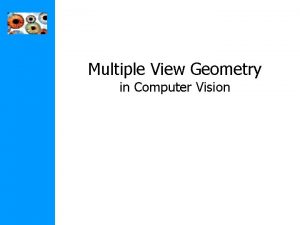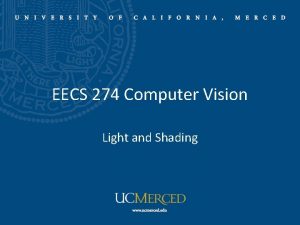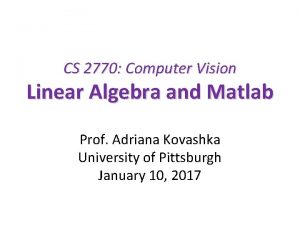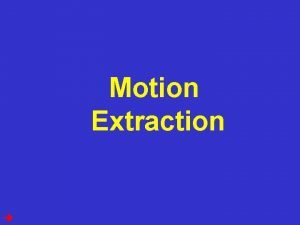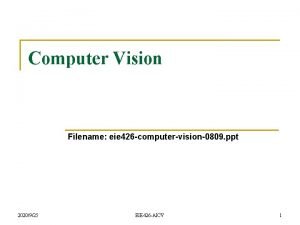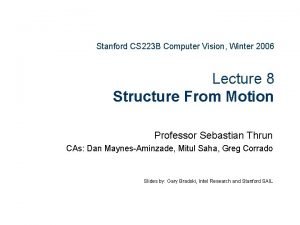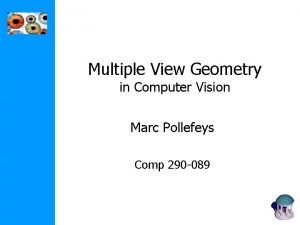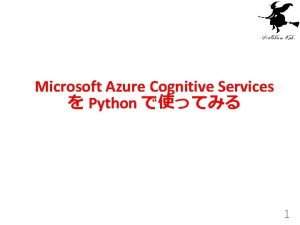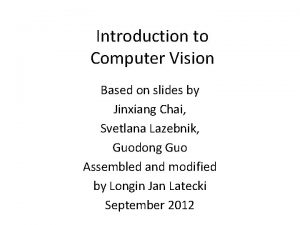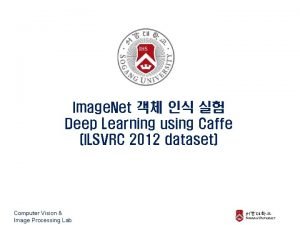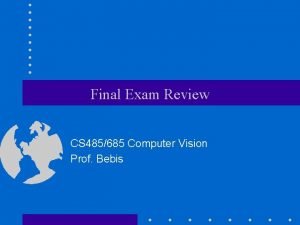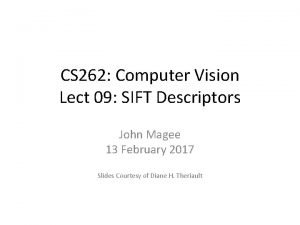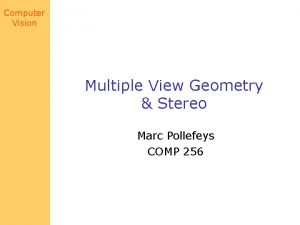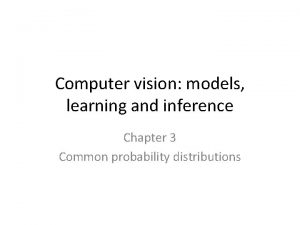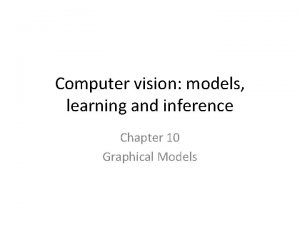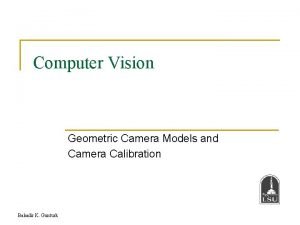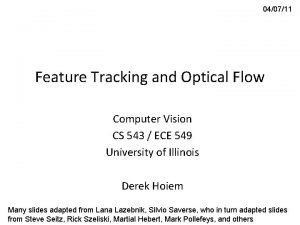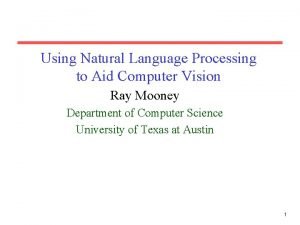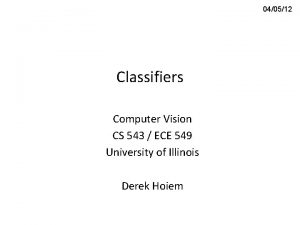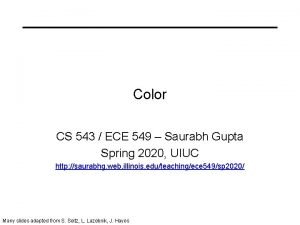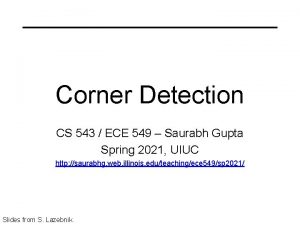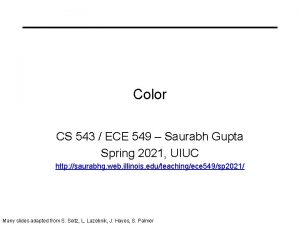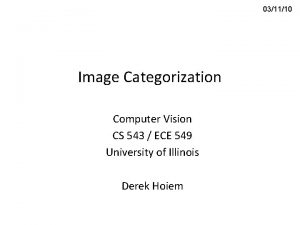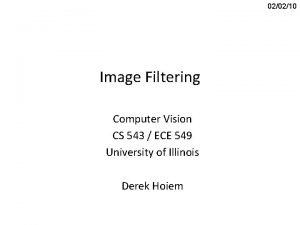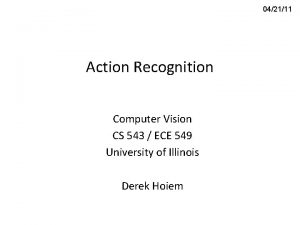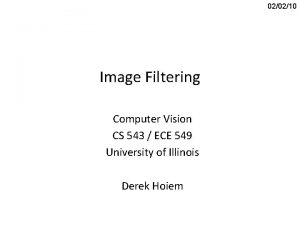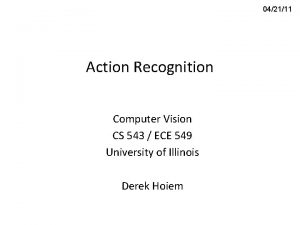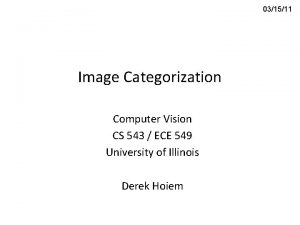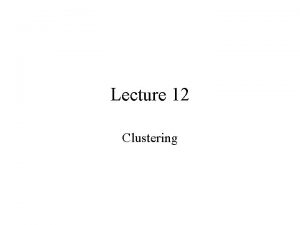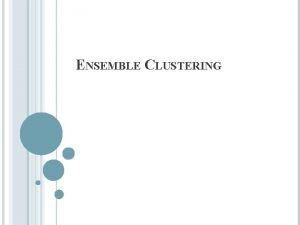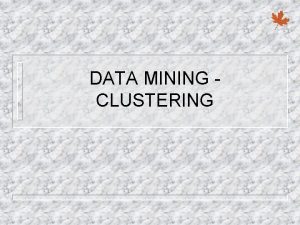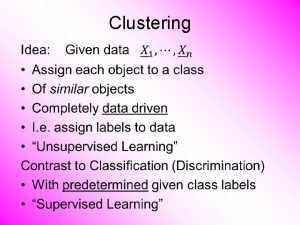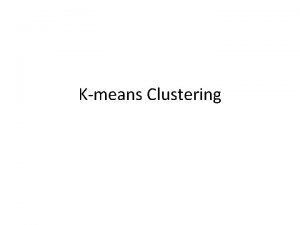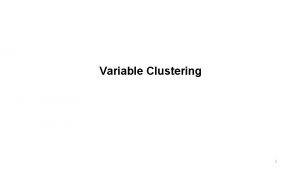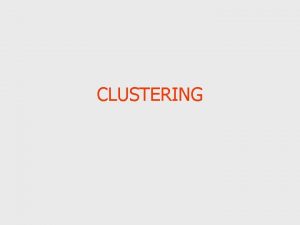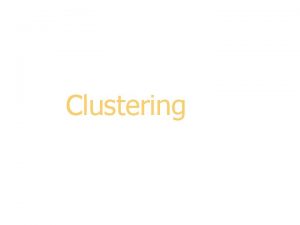021711 Clustering Computer Vision CS 543 ECE 549










































- Slides: 42

02/17/11 Clustering Computer Vision CS 543 / ECE 549 University of Illinois Derek Hoiem

Today’s class • Fitting and alignment – One more algorithm: ICP – Review of all the algorithms • Clustering algorithms – K-means – Hierarchical clustering – Spectral clustering

What if you want to align but have no prior matched pairs? • Hough transform and RANSAC not applicable • Important applications Medical imaging: match brain scans or contours Robotics: match point clouds

Iterative Closest Points (ICP) Algorithm Goal: estimate transform between two dense sets of points 1. Assign each point in {Set 1} to its nearest neighbor in {Set 2} 2. Estimate transformation parameters – e. g. , least squares or robust least squares 3. Transform the points in {Set 1} using estimated parameters 4. Repeat steps 2 -4 until change is very small

Example: solving for translation A 1 A 2 A 3 B 1 B 2 B 3 Given matched points in {A} and {B}, estimate the translation of the object

Example: solving for translation A 1 A 2 A 3 (tx, ty) B 1 B 2 Least squares solution 1. Write down objective function 2. Derived solution a) Compute derivative b) Compute solution 3. Computational solution a) Write in form Ax=b b) Solve using pseudo-inverse or eigenvalue decomposition B 3

Example: solving for translation A 1 A 2 A 5 B 4 A 3 (tx, ty) A 4 B 1 B 2 B 5 Problem: outliers RANSAC solution 1. 2. 3. 4. Sample a set of matching points (1 pair) Solve for transformation parameters Score parameters with number of inliers Repeat steps 1 -3 N times B 3

Example: solving for translation B 4 A 1 A 2 B 5 (tx, ty) A 3 B 1 B 2 A 4 A 5 B 6 B 3 A 6 Problem: outliers, multiple objects, and/or many-to-one matches Hough transform solution 1. Initialize a grid of parameter values 2. Each matched pair casts a vote for consistent values 3. Find the parameters with the most votes 4. Solve using least squares with inliers

Example: solving for translation (tx, ty) Problem: no initial guesses for correspondence ICP solution 1. 2. 3. 4. Find nearest neighbors for each point Compute transform using matches Move points using transform Repeat steps 1 -3 until convergence

Clustering: group together similar points and represent them with a single token Key Challenges: 1) What makes two points/images/patches similar? 2) How do we compute an overall grouping from pairwise similarities?

Why do we cluster? • Summarizing data – Look at large amounts of data – Patch-based compression or denoising – Represent a large continuous vector with the cluster number • Counting – Histograms of texture, color, SIFT vectors • Segmentation – Separate the image into different regions • Prediction – Images in the same cluster may have the same labels

How do we cluster? • K-means – Iteratively re-assign points to the nearest cluster center • Agglomerative clustering – Start with each point as its own cluster and iteratively merge the closest clusters • Spectral clustering – Split the nodes in a graph based on assigned links with similarity weights

Clustering for Summarization Goal: cluster to minimize variance in data given clusters – Preserve information Cluster center Data Whether xj is assigned to ci

K-means 0. Initialize Cluster Centers 1. Assign Points to Clusters 2. Re-compute Means Repeat (1) and (2) Illustration Source: wikipedia

K-means 1. Initialize cluster centers: c 0 ; t=0 2. Assign each point to the closest center 3. Update cluster centers as the mean of the points 4. Repeat 2 -3 until no points are re-assigned (t=t+1)

K-means: design choices • Initialization – Randomly select K points as initial cluster center – Or greedily choose K points to minimize residual • Distance measures – Traditionally Euclidean, could be others • Optimization – Will converge to a local minimum – May want to perform multiple restarts Illustration Source: wikipedia

How to choose the number of clusters? • Minimum Description Length (MDL) principal for model comparison • Minimize Schwarz Criterion – also called Bayes Information Criteria (BIC)

How to evaluate clusters? • Generative – How well are points reconstructed from the clusters? • Discriminative – How well do the clusters correspond to labels? • Purity – Note: unsupervised clustering does not aim to be discriminative

How to choose the number of clusters? • Validation set – Try different numbers of clusters and look at performance • When building dictionaries (discussed later), more clusters typically work better

K-means demos General http: //home. dei. polimi. it/matteucc/Clustering/tutorial_html/Applet. KM. html Color clustering http: //www. cs. washington. edu/research/imagedatabase/demo/kmcluster/

Conclusions: K-means Good • Finds cluster centers that minimize conditional variance (good representation of data) • Simple to implement, widespread application Bad • Prone to local minima • Need to choose K • All clusters have the same parameters (e. g. , distance measure is non-adaptive) • Can be slow: each iteration is O(KNd) for N d-dimensional points

Building Visual Dictionaries 1. Sample patches from a database – E. g. , 128 dimensional SIFT vectors 2. Cluster the patches – Cluster centers are the dictionary 3. Assign a codeword (number) to each new patch, according to the nearest cluster

Examples of learned codewords Most likely codewords for 4 learned “topics” EM with multinomial (problem 3) to get topics http: //www. robots. ox. ac. uk/~vgg/publications/papers/sivic 05 b. pdf Sivic et al. ICCV 2005

Common similarity/distance measures • P-norms – City Block (L 1) – Euclidean (L 2) – L-infinity • Mahalanobis – Scaled Euclidean • Cosine distance Here xi is the distance between two points

K-medoids • Just like K-means except – Represent the cluster with one of its members, rather than the mean of its members – Choose the member (data point) that minimizes cluster dissimilarity • Applicable when a mean is not meaningful – E. g. , clustering values of hue or using L-infinity similarity

Agglomerative clustering

Agglomerative clustering

Agglomerative clustering

Agglomerative clustering

Agglomerative clustering

Agglomerative clustering How to define cluster similarity? - Average distance between points, maximum distance, minimum distance - Distance between means or medoids How many clusters? distance - Clustering creates a dendrogram (a tree) - Threshold based on max number of clusters or based on distance between merges

Agglomerative clustering demo http: //home. dei. polimi. it/matteucc/Clustering/tutorial_html/Applet. H. html

Conclusions: Agglomerative Clustering Good • Simple to implement, widespread application • Clusters have adaptive shapes • Provides a hierarchy of clusters Bad • May have imbalanced clusters • Still have to choose number of clusters or threshold • Need to use an “ultrametric” to get a meaningful hierarchy

Spectral clustering Group points based on links in a graph A B

Cuts in a graph A B Normalized Cut • a cut penalizes large segments • fix by normalizing for size of segments • volume(A) = sum of costs of all edges that touch A Source: Seitz

Normalized cuts for segmentation

Visual Page. Rank • Determining importance by random walk – What’s the probability that you will randomly walk to a given node? • Create adjacency matrix based on visual similarity • Edge weights determine probability of transition Jing Baluja 2008

Which algorithm to use? • Quantization/Summarization: K-means – Aims to preserve variance of original data – Can easily assign new point to a cluster Quantization for computing histograms Summary of 20, 000 photos of Rome using “greedy k-means” http: //grail. cs. washington. edu/projects/canonview/

Which algorithm to use? • Image segmentation: agglomerative clustering – More flexible with distance measures (e. g. , can be based on boundary prediction) – Adapts better to specific data – Hierarchy can be useful http: //www. cs. berkeley. edu/~arbelaez/UCM. html

Which algorithm to use? • Image segmentation: spectral clustering – Can provide more regular regions – Spectral methods also used to propagate global cues (e. g. , Global p. B)

Things to remember • K-means useful for summarization, building dictionaries of patches, general clustering • Agglomerative clustering useful for segmentation, general clustering • Spectral clustering useful for determining relevance, summarization, segmentation

Next class • EM algorithm – Soft clustering – Mixture models – Hidden labels
 Ece 543
Ece 543 Ocr scanner
Ocr scanner Cs543
Cs543 Flat clustering
Flat clustering Partitional clustering
Partitional clustering Rumus euclidean distance
Rumus euclidean distance Cs766
Cs766 Unit 543 research project examples
Unit 543 research project examples Dansk forening for udbudsret
Dansk forening for udbudsret Opa 549
Opa 549 Nmx-j-549-ance
Nmx-j-549-ance Express 549,000 in scientific notation.
Express 549,000 in scientific notation. 543 machine
543 machine Ba543
Ba543 Ba 543
Ba 543 Ba 543
Ba 543 Cs 543
Cs 543 Cs 543
Cs 543 16385 cmu
16385 cmu Kalman filter computer vision
Kalman filter computer vision Svd example
Svd example Berkeley computer vision
Berkeley computer vision Multiple view geometry tutorial
Multiple view geometry tutorial Computer vision vs image processing
Computer vision vs image processing Radiometry in computer vision
Radiometry in computer vision Linear algebra for computer vision
Linear algebra for computer vision Impoverished motion examples
Impoverished motion examples Computer vision models learning and inference
Computer vision models learning and inference Watershed segmentation
Watershed segmentation Cs223 stanford
Cs223 stanford Multiple view geometry in computer vision
Multiple view geometry in computer vision Python cognitive services
Python cognitive services Mathematical foundations of computer graphics and vision
Mathematical foundations of computer graphics and vision Computer vision slides
Computer vision slides Ilsvrc-2012
Ilsvrc-2012 Computer vision final exam
Computer vision final exam Sift computer vision
Sift computer vision Multiview geometry in computer vision
Multiview geometry in computer vision Computer vision: models, learning, and inference
Computer vision: models, learning, and inference Computer vision: models, learning, and inference pdf
Computer vision: models, learning, and inference pdf Camera models in computer vision
Camera models in computer vision Computer
Computer Computer vision vs nlp
Computer vision vs nlp
